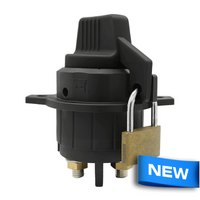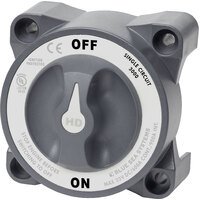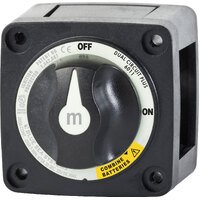
CarpeDiem
-
Content Count
1,219 -
Joined
-
Last visited
-
Days Won
38
Content Type
Profiles
Media Demo
Forums
Gallery
Calendar
Store
Posts posted by CarpeDiem
-
-
52 minutes ago, Guest said:
Double pole single throw, switch that functions as name implies.
After toing and froing I decided three +ve switches on the three batteries in two banks, and two -ve automatic voltage/current/temperature sensitive switches on the LiFePO4 right next to the -ve post courtesy of bms’s was enough isolation for me and I considered it done. The start battery -ve post could do with one to be consistent but seeing as cars are permanently wired to starter motor without any isolation switch and have multiple earth paths I don’t think I can be bothered. Lithium is another level or two of paranoia though.m2cw
Most cars have fusible links in the start circuit.
I wanted a way to manually isolate. In the event of an emergency it might be the relay controller that's smoking or worse the bms... The switch also isolates the BMS negative.
Unless the bms and balancing is cascaded (which is a stupid design) then you can't truly isolate a Lithium. Maybe with a 6pst switch 😂
-
-
It depends on what you want to achieve. But ultimately doesn't matter.
Some standards recommend that both sides are isolated.
Is the objective an emergency off, that isolates everything in the event of smoke? Or is the objective short term storage (1-2 weeks) to minimise all parasitic loads on a single battery?
In a dual battery system, with solar, lithium BMS, voltage senses and all the extras you find hanging off the positive terminal and as close as possible to the battery I recommend a DPST on the negative side, that fully isolates both batteries in the event of smoke. This is easy to do, because it's the only side of the dual battery system that is inherently connected together.
You can still put hefty switches on the positive side, but generally these will be upstream of other smaller loads and for a specific use case, eg, winches, starter motor, etc etc...
It's getting less and less likely that batteries are fully isolated with an off switch these days, there's too many things that we like to leave connected permanently and if you have solar then you are certainly not fully disconnecting the batteries...
eg,

-
 1
1
-
-
28 minutes ago, Bad Kitty said:
OK, so that is a true hybrid system. To motor continuously you are running a main engine, whole also charging batteries. So isn't that just a more expensive, heavier ICE drivetrain, with a whole lot more embedded carbon in it's manufacture, & battery disposal implications at some time, for the ability to motor quietly for a short distance?
I'm still not seeing the real world planet saving impact?
Well the boat also has 4kW of solar. So on a good day you could motor for 8 hrs without touching the battery...
But yes it's definitely a whole lot more expensive...
Reality is you don't need the generator. But everyone wants the generator because of range anxiety.
An OceanVolt spec'd plug in non hybrid package (no generator) for Carpe Diem that would weigh less than the engine, take less space than engine and fuel tank, would give me 50Nm of range fully charged from shore power.
The only time I have ever motored that far is on a time sensitive trip... otherwise I wait for the wind. So I would need to change my ways. Which I won't be cause I just repowered
 and if that engine gets 50 years it will outlast me.
and if that engine gets 50 years it will outlast me.
-
2 hours ago, Bad Kitty said:
You can't run the generator to charge the batteries & motor continuously.
That's exactly what you do.
The HH44 has a 10kW engine which is just a stock standard 3 cylinder kuboto red mechanical diesel that we all know. It has a 10 kW generator attached to the output shaft and also has the typical shaft drive propellor that most boats have.
So the 10kW engine can be delivering 6kW to the drive shaft propelling the boat while driving the generator at 4kW charging your battery bank.
When you stop the engine the battery powers the generator spinning the drive shaft.
When you put the sails up the propellor spins the generator charging the batteries.
This is even more efficient than hybrid cars which convert mechanical to electrical and back to mechanical. And hybrid cars have been charging batteries while you drive since forever.
-
42 minutes ago, Saltynuts said:
Without getting into the politics of the global warming nonsense, it doesn't stack up environmetally either.
https://www.yachtingmonthly.com/news/electric-propulsion-not-most-green-study-finds-95997
That's a great article. Thanks for sharing.
I feel like I missed an opportunity to go electric 5 yrs ago... Now reading that maybe I didn't.. Haha
-
18 minutes ago, waikiore said:
Then of course what happens to the large battery bank when it is had it.
LTO cells have 30000 cycles.
LFP cells have conservatively 3000 cycles. Most now have 7000 cycles.
Assume you are in a marina, you charge your batteries every week and you motor your full battery capacity (call it a conservative 15Nm) every weekend on a 3000 cycle battery bank...
That's 57 years of weekend usage. They are going to outlast the boat.
You run the generator occasionally cause you picked a light wind weather window and you are on a tight schedule.
After 4.5 years I have put 225hrs on the engine. The most use it gets is making a deadline cause theirs no wind. Which is typically the delivery home from coastal or bay week.
I have room for a smaller lighter engine, fuel and 24kwh of batteries. Which apparently would give me 20Nm at 4knots.
The numbers stack up for me.
Ymmv
-
 1
1
-
-
18 hours ago, Saltynuts said:
I really can't understand why anyone would fit electric propulsion. The extra expense, range issues and they are worse for the environment than an ice engine.
An hydro generating electric motor with appropriate battery storage and a optimally engineered ice engine is an order of magnitude better for the environment.
Running an ice engine at optimal torque with all the energy that can be being pumped into the batteries and nothing being wasted is why hybrid cars are so efficient.
On a hybrid boat you get the double whammy option of being able to have extended range by having a propellor drive as well that can be also spun by the batteries or the diesel.
When you are sailing you are also charging the batteries. And if the batteries go flat you can engage the engine.
-
16 hours ago, Bad Kitty said:
I tried really hard to make it work for me, but ended up going 2 x 40hp diesel again, and don't regret it for a minute. The all-electric solution is, imho, not mature enough or well proven enough. There are numerous boats that have gone that way, and then ripped it all out & refitted ICE drivetrains.
Ultimately, every now & then you may need to motor for 48 hours, and nothing all electric will do it. Not in small craft size.
But you have a generator for when you need it. A purpose spec'd marine generator with a matched alternator is many times more efficient than a diesel sail drive engine. Our engines waste so much energy.
I agree you can't get away from having a generator when you also have tight schedules and can't afford to Bob around for 48hrs waiting for favorable winds.
-
1 hour ago, Jon said:
Rapido 40 #07 has arrived in New Zealand!!
It's all electric with Oceanvolt and is the first Rapido 40 to have a helm wheel.
This is the second Rapido to be based in New Zealand. Rapido 60 #02, Romanza, is in Auckland.
#allectric, #helmwheel, #rapido40, #oceanvolt
from bookface
I love the OceanVolt range. I really regret repowering to another diesel. A definite case of not knowing what I know now. 3 years ago I just thought I knew that diesel was the only option and there was no way electric could ever be an option... boy have I learned a lot.
Where is Romanza now? Was on the poles at Westhaven but I have not seen her for a long time...
A beautiful boat.
-
1 hour ago, khayyam said:
My understanding is that the threshold is quite low, too.
This year it is $140k (ish) - so the most you get is 80% of that, which you will pay tax on - anything above that you need income protection insurance for.
I will not judge if that is "low" or "high"

-
3 hours ago, K4309 said:
I'm not sure how ACC covers loss of income for small businesses / tradies, my understanding is it is in-effective. Business insurance is generally required.
It doesn't at all. It covers 80% of your personal income up to a threshold. After that you need income protection insurance.
A lot of self employed eg tradies, come unstuck with income under the table or using valid options to reduce there income, eg fringe benefits...
-
1 hour ago, aardvarkash10 said:
Wording from a Vero boating policy, exclusions:
"damage deliberately caused by the wrongful or reckless acts or wilful misconduct of any insured person;"
If I were an inusurer, I would claim that navigating among other craft at several times the speed limit while not at the wheel or in control of hte boat qualifies as wilful misconduct.
They may get hung on the "deliberately" bit and a lack of oxford commas.
There's nothing to suggest this was a "deliberate" act. That's would be a very high bar to pass.
He plead guilt to dangerously operating a vessel. That's a far cry from deliberating ramming your vessel into another.
He didn't purposefully set out to ram the ferry. It was not a deliberate act
-
 1
1
-
 1
1
-
-
2 hours ago, ex Elly said:
He was remanded at large and will be sentenced in June. The charges are laid under the collision prevention rules of the Maritime Transport Act 1994 and carry a maximum penalty of 12 months’ jail or a $10,000 fine.
He hasn't been fined yet. He could get jail time.
It will be a steep hurdle to cross to get jail time - I would suggest he won't even see the full $10k of the fine.
If there is no precedence then it will be in the 2k - 5k range. If there's precedence then it will depend on what those fines were and what they were for.
-
3 hours ago, Terry B said:
Hi Aard, agree he's up for heaps however that's not what the law should take into account.
Unbelievable that a man loses his boat and suffers severe health consequences and this guy who caused it gets a $10,000 fine.
Recompense for the ferry guy? Apart from insurance on the ferry? What about his costs for on going health issues, loss of income, etc, etc?
New Zealand has ACC.
While ACC is often unfair to the victim and victims often end up worse off, that's just the way it is.
Our ACC is considered world leading and is envied by the developed world.
-
 1
1
-
-
On 22/02/2024 at 5:34 PM, Black Panther said:
So time goes faster for them.
The GPS satellites are also impacted by special relativity which says the faster you go the slower time passes. But they aren't going fast enough to cancel out the effects of gravity... So overall time goes faster (relative to us mortals).
On 22/02/2024 at 5:34 PM, Black Panther said:The GPS satellites are further from the earth than the space station. Far enough that they experience a different space/time than earth.
The iss is also affected by less gravity, but is going so fast that special relativity cancels out the gain from less gravity and overall time goes slower. (Again relative to us mortals.)
I don't have a clue why, like I know the earth is flat, it just is

-
19 minutes ago, Frank said:
Talk to Kerry at the Marina shop (Insurance broker)
kerry@themarinashop.com
Thks. Will pass it on.
-
A friend who is purchasing a relatively new 50ft production Cat has been told by his insurance broker that he'll be very unlikely to be able to get insurance for off shore if the vessel is NZ flagged.
Have another friend with a 54ft Halberg Rassy who goes to the Pacific Islands every NZ winter. They registered out of Cook Islands because no one would insure them if it was NZ flagged.
Seems that the reasons for a foreign flag aren't just to avoid Cat 1.
-
13 minutes ago, ynot said:
I've had two go from new motor in three years.
I think dry start ups are the culprit ...for whatever reason you have a dry start...barring the maybe faulty one.
I have noticed that after a longish period sailing at a reasonable pace...eg quick for a few hours or a dozen or more hours when I start up the donka donka it takes a while to pump...no alarm fitted but my ears tell me!..that hollow exhaust sound of oh f*ck.
I have taken to shutting off seacock when I know we are going for a Hoon for hours for example ssanz or whatever.
Initially I had a loop with a anti syphon at the the top...bad move because IMO when the pump sucks it also sucks air thought it...negative pressure! and when motor is stopped air enters through the anti syphon and the water from that high point through venturi effect gets sucked out.
My anti syphon was quite high above the top of heat exchanger.
Am i making sense or jibberish
Perfect sense. We get the empty effect after being thrown around in swells. Doesn't happen often and only ever after rough conditions. It's very noticeable with the alarm, the alarm cuts off after about 2-3 seconds.
My theory is that the saildrive is coming out of the water allowing the water to drain out and air to get in.
The anti-siphon on the d1 should be after the impellor! Between the impellor and the HX.
On the larger D2's it should be after the HX. Between the HX and the exhaust mixer.
It certainly should not be before the impellor so no chance for the impellor to suck on it.
-
Do these generally just fail on start up? Or are they just as likely to fail during motoring?
I installed a water flow alarm - so if it fails I will know instantly - but knowing instantly while in an inconvenient spot may not help...
-
1 hour ago, K4309 said:
Serious question - I've been told I need an LPG alarm at the lowest point in the bilge. How then do you keep it in good working order, given the risk of water in the bilge?
I got told to put it above the lowest point at a point where I felt it would not get wet. Gas fitter was quite clear that I knew the boat and that I could make the call. We have a nice teak grate at the bottom of the steps adjacent to the stove.
When racing pulling in a scalloped kite, or in severe rain it can end up with with a few inches of water in it that slops around. Coming downstairs with soaking wet weather gear its a great place to strip off...
It's always a compromise and is another item that has to be maintained, checked and loved.
All up we have 14 independent disconnected "bilges" under the floor boards - it's impractical to put a sensor in each...
-
2 hours ago, K4309 said:
If it complies with the relevant NZ standard, what have Worksafe got to do with it?
Because Worksafe controls the secondary legislation which specifies what gas bottles can be imported to, or manufactured in, NZ.
It used to be all under MBIE but when Worksafe split this went with them.
-
Quote
LPG installed to current NZ Standards?
Kind of a conundrum isn't it?
How can you be compliant with a standard which according to that standard, doesn't apply, if your installation predates said standard?
Personally I think that saying I am compliant, without making it clear that the standard does not apply to me would be misleading my insurer and imho goes against the well established doctrine of utmost good faith... and I might find my insurance revoked in the event of a claim.
ymmv
-





SailGP
in RaceTalk
Posted
https://www.doc.govt.nz/news/media-releases/2024-media-releases/doc-statement-sailgp-lyttelton/
DOC does not have a role in permitting or allowing the race to go ahead.
The marine mammal management plan was developed by and belongs to the race organisers. DOC does not have a role in implementing it.
SailGP has chosen to hold its event in a marine mammal sanctuary that was established for the protection of Hector’s dolphins.